

Dagl1
-
Posts
365 -
Joined
-
Last visited
-
Days Won
4
Content Type
Profiles
Forums
Events
Posts posted by Dagl1
-
-
28 minutes ago, MigL said:
I would assume it is the superposition of the quarks that is collapsed by the interactions.
The proton itself can still remain in a superposition of its own states.After all, an atom can be in a superposition of states, yet its constituent electrons are continuously interacting with its nucleus.
EDIT: cross posted with your response to Swansont.
The wave function describing all possible observables of an atom ( say Hydrogen to keep it simple ) does not consider the proton in the nucleus at all, just the potential arising from its presence, and how the electron is affected by it.
It is after all, solely the electron 'configuration' that determines how the atom interacts with other atoms.Okay but shouldn't the potential that arises from it presence be determined by the wavefunction of the proton? and shouldn't that be interacting with the wavefucntion of the electron (sorry for basically asking the same thing, I don't really get it;p).
0 -
22 minutes ago, swansont said:
"Being measured" is a very vague way of describing this issue. Wave function collapse implies there is a superposition of states. What superposition would be present, that is removed by quark interactions?
Hmm so I thought that the wave functions/superpositions of the quarks make up the complete superposition of the proton.
I have an additional question in the same vein (and to which you will probably answer the same thing); an electron 'orbiting' a proton is interacting with that proton. The electron is 'confined' to that orbital due the quantum nature of orbitals (if I am not mistaken). But the probability of finding an electron is based on the position of the (centre of) the atom.
I don't know if I am wording this correctly but, I would think that the places where we could find the electron, are based on where we could find the proton. So then I also imagine that they must be constantly 'exchanging information' and therefore the superpositions of both should collapse (?)I can imagine that the interactions of quarks within the proton don't affect the superpositions of the proton as a whole, but then I don't get how that would work for interactions between different particles (a proton, neutron and electron together for instance, these must constantly be interacting, so then shouldn't the superpositions they are in collapse or be limited in some way?)
My apologies if I completely misunderstood what you are hinting at with your question.
Thanks againEdit: While I understand that the Atom itself could be in a superposition of states as a whole, I don't understand how there are still probabilty functions for, for instance, the electron orbitals as seen on the picture here: https://en.wikipedia.org/wiki/Atomic_orbital
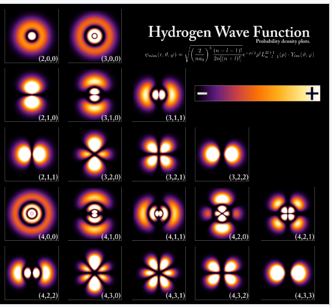 0
0 -
Hello,
I was thinking of wave-form collapse and how this is the result of interactions of particles (? in case particles isn't correct, interactions of things). A proton consists of 3 quarks that 'undergo' colour changing. This is mediated by gluons. As this is part of/result of strong interactions, I presume we can consider colour change an interaction. Why do these interactions not result in every proton always being measured.
I suppose that wave-form collapse may not be a Yes or No thing, but that such small 'interactions' only lead to reduction(?) of the total wave-function. (I have no idea, I could and probably am wrong, but feel that I should at least attempt coming up with an idea myself before asking).
Thank you for your time and have a nice day,
Dagl0 -
Ah okay, that makes sense, thanks!
0 -
Hi,
I have recently started going through a python textbook and in one of the exercises I find myself not really understanding why the code does what it does.
The reason why the 0+1 is there, is that in the actual program those will be the iterable (i) in a loop.
The code should swap two values in a list , I guess that itself can be done more simply than this code, but I will search/figure that part out myself.
I am most interested in the behaviour of the following Python 3.8.1 code (I added comments with what I THINK should/would happen).List = [5,1,2,3,4]
TempList = List # Set Templist equal to List
print(List[0]) # Returns 5TempList[0] = List[0+1] #replace first element in TempList with second element of List
TempList[0+1] = List[0] #replace second element of TempList with first element of List
print(TempList,List) # Returns[ 1, 1, 2, 3, 4] [1, 1, 2, 3, 4]What I don't get here is, the way I understand how variables change, is that only TempList should be different now? We only 'read' the values of List[0+1] and List[0] right? (Well obviously not, but could someone show me what I am getting wrong or referring me to a source that explains this?
I looked through this, but didn't see it (although I skimmed and did may have missed it): https://docs.python.org/2/tutorial/datastructures.html#tuples-and-sequences
Thanks in advance,
DaglSo I have found the answer, I should use:
TempList = List[:]
But I don't really understand why.
a = 5
b = a
a +=5
print(b) # returns 5, not 10what exactly is different when we say:
TempList = List
from:
b = a
Thanks0 -
Ahh I see, my bad.
0 -
Thank you, I never realised all ribosomes are cytosolic and then can transfer to the ER, thanks, I'll go read some stuff about it.
51 minutes ago, CharonY said:As a whole, there is more recognition of ribosomal dynamics, which respond to a vast number of cellular cues (such as stress).
Than recognition of? Do you mean, there is more recognition of ER-ribosomal dynamics, which respond...
Thanks again0 -
I have recently started looking back at the function of the Golgi complex and am now aware not all proteins pass through the Golgi Complex (cytoplasmic translation). However I was always under the impression that most post-translational modifications (PTM) happen in the ER (co-translational) or Golgi complex.Additionally, some types of PTMs happen in the mitochondria or at other organelles (transmembrane receptors come to mind).My questions are fourfold:1. Are there specific PTM's exclusive to the Golgi complex.2. By what mechanism can proteins translated by cytosolic (floating) ribosomes be folded and modified (in the ER the concentration/location of chaperone proteins and PTM-proteins will be much higher, but I can't imagine how that works for cytosolic ribosomes).3. Are (some) proteins translated by cytosolic ribsomes still transported to the Golgi?4. In case cytosolic ribosomes and ER ribosomes produce different (types) of proteins, how do they know which mRNA's to translate, or how does the mRNA reach the right ribosomes (escape the ER in case of cytosolic ribosomes)?
Especially the last question is one that I find very curious (in case there are proteins that go to either the ER or Golgi, but not to both).
I suppose mRNA export pathways together with specific RNA binding molecules could lead to no translation in the ER, but I haven't found clear data on this yet.
Thanks in advance
-Dagl0 -
The initiation of a full 'firing' generally happens at axon hillocks. So as the page says, the closer to axon hillock, the stronger the signal will be when it arrives there. But the activation function can remain the same.
You should note that the synapses can change, and each synapse can react differently to the same signal. I would recommend going over this neuronal pathway. The point is to understand the dual role dopamine has here. https://www.intechopen.com/books/basal-ganglia-an-integrative-view/clinical-motor-and-cognitive-neurobehavioral-relationships-in-the-basal-ganglia
While googling for the picture, I came across this:
https://www.eneuro.org/content/5/6/ENEURO.0339-17.2018 maybe also interesting for you.
For your project, it may be good to just boil it down to the most simple/important pieces and design those first.0 -
1 minute ago, ALine said:
Ye! helps out a whooooole lot. If I were to give a general reference understanding to this I would call it a kind of "spark gap" which requires a certain amount of "charge" in order to "fire." This previous statement is used in order to give myself an understanding of what behaviors it associates to also seen.
Ye check this out as well; https://en.wikipedia.org/wiki/Summation_(neurophysiology), many small sparks can still lead to firing.
0 -
How much do you want this to resemble real neuronal transmission (of course, we ignore the different receptor/neurotransmitters)?
I don't know enough about engineering to help you out with this, but maybe the explanations of neurons firing helps you enough to continue
Let's take a look at the action potential (1 'firing'):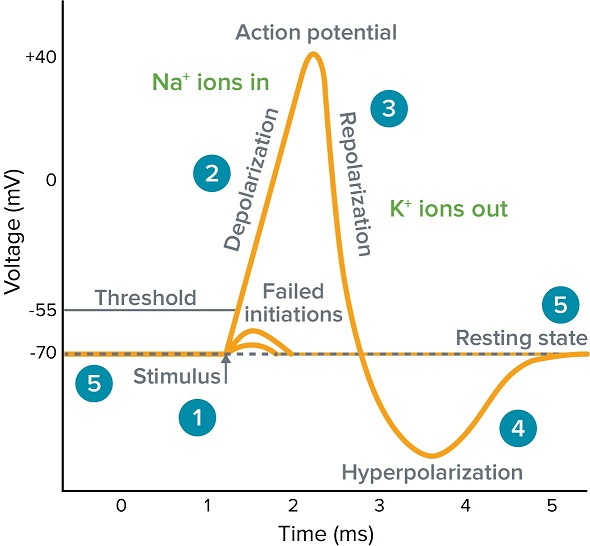
The voltage difference shown here is between the inside and outside of the cell, due to ion gradients. between the inside and the outside are many pumps/transporters that (CAN) let through ions. Some of these are themselves activated by specific voltages, we call these voltage-gated ion channels.
When we look in the picture, at 1 (stimulus) we can see some failed initiations, which do not reach the threshold (~ -55mV). Such a stimulus could be another neuron that has just sent neurotransmitters to our cell (and we have the right type of cell/receptor to be activated). If the signal is weak, we have a failed iniation. But when we reach -55 mV, the voltage-gated ion channels open, and a sort of sequence of events happens. The voltage gated Na+ channels open up and Na+ streams out, leading to further depolarisation. After a little while, slower K+ channels open and the cell repolarizes. During the hyperpolarization phase, K and N ions are pumped to the other sides of the membranes so that the next time the channels open, this exact same thing can happen.
https://en.wikipedia.org/wiki/Action_potential
This action potential then travels across the myelin sheath, getting a signal boost at nodes of Ravier, where more voltage-gated channels are activated to further the signal.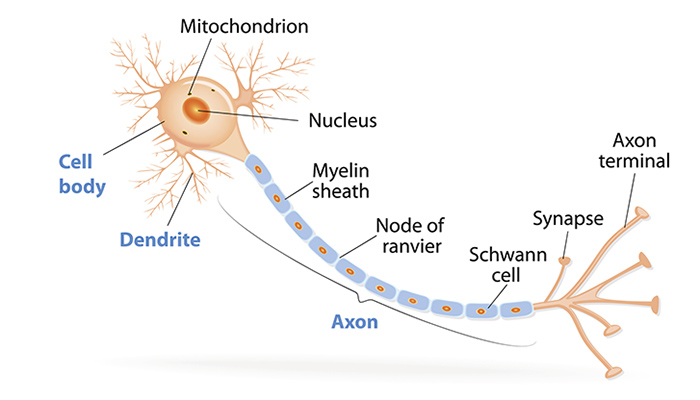
When the signal reaches the axon terminal, it will send this signal to thousands of different synapses, which connect to other cells.
A big part of how neurons learn is called synaptic plasticity, and in a really oversimplified example, when you think of a dog, one particular pattern of probably millions of neurons activates. Not all cells/synapses are equally activated, so if you think of dog a lot, your cells will increase the signal transduction (or decrease for the opposite effect) in these active synapses. This means that the same action potential can now lead to a stronger neurotransmitter release, or if its post-synaptic adaption, maybe the the same amount of neurotransmitter now gives 1.5x the amount of signal in the next cell.Synaptic plasticity: https://en.wikipedia.org/wiki/Synaptic_plasticity
So important things is that neurons have many (variable) outputs and inputs. Activation requires a threshold (Sigmoid curve is probably useful for modeling).
Hope this helps, at least a little;p
-Dagl
1 -
The subunits that let through protons across membranes. ATP synthase has asymmetric subunits which is one of the reasons that movement 1 way and movement another way facilitates 2 separate processes.
In the case of MotA/MotB, I thought that I once saw a picture that showed the inner channel to be symmetric (so that proton movement could be facilitated in both directions).
Basically, when ATP synthase turns the other way, by definition we are using energy to move protons towards higher potential energy. But the flagellum just moves the protons from [high] to [low] regardless of the direction the subunits are going and thus always produces energy. Please note that the gearbox idea on its own should suffice and that I cannot find this picture or something like it, so I may have misremembered or the source was not as truthful as I thought it to be.0 -
Yes that, and I believe I read that the ATP synthase rotor is asymmetric, while I thought the MotA/MotB of the bacterial flagellum was symmetric but now I can't really find any evidence for that (maybe there is, but can't find it easily).
0 -
Wouldn't you be better off showing reasons why sleeping/marrying (note we are NOT talking about getting children here, are we?) is bad from a non religious point of view.
Yes I do believe that in incestuous relationships there is a higher chance of abusive or unhealthy power dynamics (and I suppose you could even argue that there is always an inherit difference). Other than that, what are reasons that it would be bad?
0 -
1 minute ago, Strange said:
I don't think we want to get into a discussion of individual posts or members, and whether what they said breaks the rules. We have people to look after that. Sometimes we see things that we then act on. Sometimes we rely on people reporting it. Sometimes people report things as a "personal attack" or an "insult" and we don't think it is any such thing, so we don't act on it.
There are plenty of people who have been warned, suspended or banned (and, in rare cases, their posts hidden) for breaking the rules on civility.
So, again, if anyone sees anything that they think breaches our rules (which are sometimes 'more what you'd call “guidelines” than actual rules') please report it.
Okay, I see.
It is just frustrating as no discussion can be had with the current amount of specificity by wallflash. But I definitely get why we don't want to go after individual posts/members. My bad.-Dagl
1 -
10 minutes ago, wallflash said:
No. Before I begin though, what is the acceptable percentage allowed of telling people to STFU and calling them liars, trolls , and ignorant . If it exceeds that then maybe I will bring it up

Wow , I’m in the red for bringing up the topic of insulting !
 LOL
LOL
Please just post the things you have issues with...
0 -
Agreed Charon, I was talking about the lower end of the degrees.
Ahh Okay String
0 -
3 minutes ago, hypervalent_iodine said:
As the only one here with direct experience with where the OP is from and the universities she has access too, I can tell you that she will need chemistry just to get into the degree, and will almost certainly need to do one or both first year chemistry courses.
My bad, I completely ignored the part where you actually know what she will do;p sorry! I edited my previous post to reflect your quote (but kept the rest as I still think for other instances its applicable).
Sorry OP for bringing about misinformation...
-Dagl
0 -
For OP, please ignore my ramblings as I didn't register that Hyper has gone to the universities you are looking for!:
3 minutes ago, hypervalent_iodine said:As the only one here with direct experience with where the OP is from and the universities she has access too, I can tell you that she will need chemistry just to get into the degree, and will almost certainly need to do one or both first year chemistry courses.
I find that we may either just disagree regarding how important chemistry knowledgde is or how much of that knowledge is needed. Especially if, such as the OP, you are interested in macro-biology (not sure if that is the correct term for entomology), when will you need to apply chemistry?
Even in molecular biology does it not seem to come up a lot (right? (not trying to assert, just wondering why we disagree on this @CharonYand @StringJunky)), with maybe the exception of: understanding protein function based on crystal structure, kinetics and... lab work (but even then, you don't NEED to know the chemistry, you just need to accept that certain stuff does something).
Please not that I am not arguing that chemistry is not useful, I think that it brings a much deeper and fundamental understanding of certain things, but I don't feel like you need to know a lot of chemistry to understand biology (but again, here we may disagree on the type of 'understanding' one wants).Let's take a look at cells, understanding the central dogma doesn't require chemistry, understanding what proteins do doesn't require chemistry. Understanding the mitochondria... doesn't really require chemistry (I think that last one will maybe clarify in what we mean 'need'). For trouble shooting in lab conditions/experiments, it will definitely help, but by that time you are so far along that you can just learn it on the side.
Actually, now that I think of it, it is the point I think I wanted to make to OP: if right now chemistry is too abstract and strange, I don't believe it is necessary to understand it right now. By the time (based on my own experience), you come across chemistry knowledge that you will need or that would aid in understanding some biology stuff, you will probably have already some fundamental biological knowledge, so then it becomes easier to isolate the thing in chemistry that you need to understand. I think you can get quite far in biology without having much understanding of chemistry.
@Jemma Do note that CharonY and (sorry if I am mistaken here) StringJunky are much older than me and have at least 1, possibly multiple PhD's more than me (note, I have 0), so they are likely to know better than me!Ps:
Even for things such as the cell membrane, you don't need to understand chemistry to understand what it does right: 2 layers, each made of a water-loving and water-hating part. Water is on both sides of the membrane so the water-loving parts will be on the outsides, with both the water-hating parts stuck together in the middle. The water-hating part doesn't mix well with water so you have a plasma membrane which keeps water in/outside?-Dagl
0 -
5 hours ago, MigL said:
Well it may help to consider that photons interact with the electrons in the medium they are traversing, and that leads to an 'effective' speed reduction. But actually, between each interaction, they still travel at c .
Gravity is self-interacting, so one could assume massless gravitons travel at c also, except when they interact with themselves to reduce their effective speed. These would be the 'tails' Markus refers to
Thanks! The big one of that is the self-interacting part, I had trouble imagining it (and now that I see the answer, once again, I should go and study the maths for a real answer).
@Mordred Thank you very much for this gem of information! Like always, I understand about half. But I also don't understand the mechanism by which two cables interfere with each other (I never stood still by that, but always assumed it was because both wires induce a magnetic field and that (for whatever reason) 'annoys' the signal that is travelling through both).
From your explanation I think I do get that I can't think of the self interaction as turbulence. The wave itself changes the curvature of spacetime and that is why it pulls on/interacts with itself?
Thanks again everyone!
Dagl0 -
5 minutes ago, SergUpstart said:
The speed of propagation of electromagnetic waves is slowed down in the material environment. There is no absolute emptiness Natura abhorret vacuum.
I consider the gravitational field as a material medium in which the velocity of electromagnetic propagation varies depending on the strength of the gravitational field.
Right but several physicists seem to disagree with you, what is the point of saying: "I consider the gravitational field as x " when they are TELLING you that that is not the right way of looking at it. You don't discuss or give counterarguments to their whole posts, and instead you tell us what you consider, but why?
Are you here to learn or to discuss or postulate, if its one of the first 2, it may be a good idea to: if you believe something different from what physicists are saying, to provide A LOT of evidence. One thing they have over a lot of laymen like me, is that they actually look at and understand the math. So why not post math to prove your point?
You are currently saying that basically the whole of special (? that is the one that sets the upper limit as c and also that anything mass-less can only travel at c, right?) relativity is wrong.
So for that you have to provide a lot of evidence.
As far as I understand the general consensus among physicists, GR and special relativity hold up particularly well, so if what you say is refuting GR/SR, you will need extraordinary evidence. (I of course could be wrongly interpreting what you say as refuting GR, so I hope someone who actually knows physics can correct my mistake if SergUpstart's comment falls well within SR/GR).-Dagl
0 -
Addition:
and here is another source about it, its quite interesting, thanks for asking!
https://www.ncbi.nlm.nih.gov/pmc/articles/PMC4938800/
-Dagl
0 -
At least from what I have seen myself, a lot of fields within biology use little to no chemistry and only a little math. Of course, during your studies you will probably have courses that focus on these two topics, but in my experience, if you aren't planning on doing something that specifically uses concepts from chemistry/math to solve certain problems, then you just need to get through some courses and after that you won't encounter it too much.
Definitely don't think that you wouldn't be smart enough for biology, I think biology is in a lot of ways like history. There's a lot of jargon and specific details that are handy to know, but the general concepts of almost every detail are not too difficult and most of the time can be translated to some analogy that is easy to understand. Just be interested, curious and study a lot and all will be well (oh of course do follow hypervalent's advice, just wanting to point out that I really think everyone can learn biology;p).-Dagl
0 -
https://link.springer.com/article/10.1007%2Fs00232-014-9760-y
This is what you are referring too?I may be thinking too simply but wouldn't the reason that this happens just be energy-conversation? If rotating sideways in the x direction allows protons to move from a higher (potential?) energy state to a lower one, and that energy is then bound to ATP. Then if you want to do the opposite, the rotation will also be in the y (the other) direction. As now we want to use the energy contained in ATP to produce protons with higher (potential?) energy.
I think after a brief look that the reason is the difference in structure, bacterial flagellar motors have quite a different structure and contain a specific 'C ring' which acts like a gear (think of setting your car in reverse). Also it is important to note that they only move clockwise for a few rotations and then change back to regular counterclockwise rotation, if I have interpreted this right.Oh I recommend adding sources to your questions, it makes it easier for people to look stuff up and help you!
https://www.sciencedirect.com/science/article/pii/S2001037019302338#bb0010(source of the ATP synthase picture: https://www.nature.com/articles/46193)
-Dagl
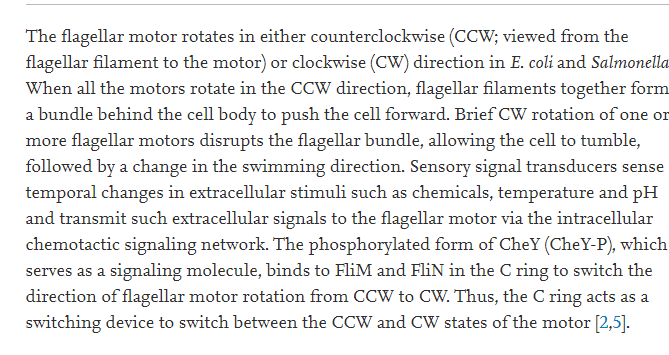
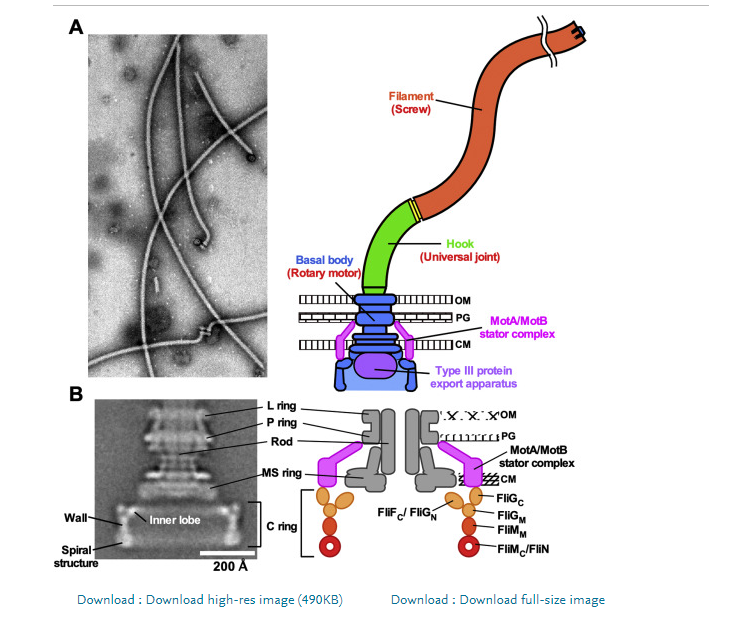
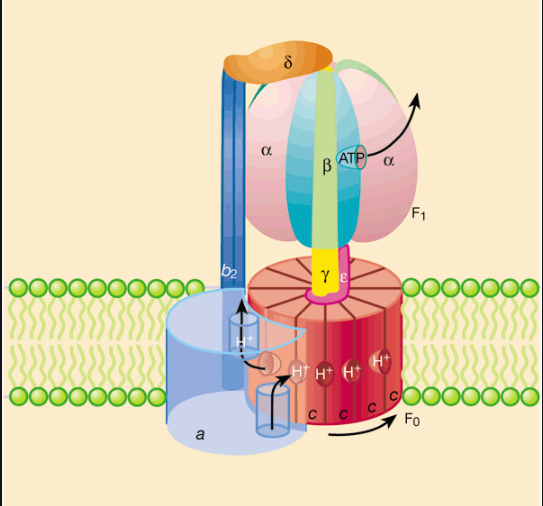 0
0

Why do quark interactions not lead to wave function collapse?
in Quantum Theory
Posted
Okay,
I can't really answer your questions, but I think I understand it now. It's not just any interaction that leads to collapse of any of the superpositions, so the electron doesn't lead to any collapse of the spin superposition states.
I hope I get it now,
Thank you both!